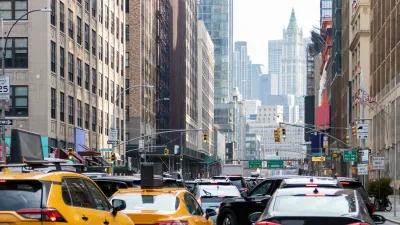Cities such as Dallas, Denver, Sacramento and Tampa are reversing course on their one-way streets for a number of reasons; but improving traffic flow likely isn't one of them. Eric Jaffe looks at a recent study that upends conventional wisdom.
While two-way streets may be more attractive for their livability, ease of navigation, safety, and economics, the conventional wisdom is that one-way streets are better for traffic flow. However in a recent paper published in the Transportation Research Record, Vikash Gayah, a civil engineer at Penn State University, makes the case that two-way streets can also improve congestion.
"The typical metric of traffic is vehicle flow — which amounts, more or less, to standing on the corner and counting how many cars go by," explains Jaffe. "Flow is high on one-way streets because there's little reason for cars to slow down. But flow doesn't take into account the fact that traveling through one-way street systems often means taking a circuitous route, which adds distance to every trip."
"You can move more vehicles through a roadway, but if they have to travel a longer distance, in the end, you have actually fewer people being able to get to their destination and get off the road," says Gayah.
"So [based on Gayah's theories] cities looking to improve trip capacity in downtown areas have some options," suggests Jaffe. "Smaller cities, with shorter average trip lengths, should be able to reduce congestion by converting one-way streets into two-way streets (with a couple options for left turns). Larger cities, with longer trip distances, should consider a shift to two-way systems that ban left turns entirely."
Thanks to Erica Gutierrez
FULL STORY: The Case Against One-Way Streets

Alabama: Trump Terminates Settlements for Black Communities Harmed By Raw Sewage
Trump deemed the landmark civil rights agreement “illegal DEI and environmental justice policy.”

Planetizen Federal Action Tracker
A weekly monitor of how Trump’s orders and actions are impacting planners and planning in America.

The 120 Year Old Tiny Home Villages That Sheltered San Francisco’s Earthquake Refugees
More than a century ago, San Francisco mobilized to house thousands of residents displaced by the 1906 earthquake. Could their strategy offer a model for the present?

In Both Crashes and Crime, Public Transportation is Far Safer than Driving
Contrary to popular assumptions, public transportation has far lower crash and crime rates than automobile travel. For safer communities, improve and encourage transit travel.

Report: Zoning Reforms Should Complement Nashville’s Ambitious Transit Plan
Without reform, restrictive zoning codes will limit the impact of the city’s planned transit expansion and could exclude some of the residents who depend on transit the most.

Judge Orders Release of Frozen IRA, IIJA Funding
The decision is a victory for environmental groups who charged that freezing funds for critical infrastructure and disaster response programs caused “real and irreparable harm” to communities.
Urban Design for Planners 1: Software Tools
This six-course series explores essential urban design concepts using open source software and equips planners with the tools they need to participate fully in the urban design process.
Planning for Universal Design
Learn the tools for implementing Universal Design in planning regulations.
Clanton & Associates, Inc.
Jessamine County Fiscal Court
Institute for Housing and Urban Development Studies (IHS)
City of Grandview
Harvard GSD Executive Education
Toledo-Lucas County Plan Commissions
Salt Lake City
NYU Wagner Graduate School of Public Service





























